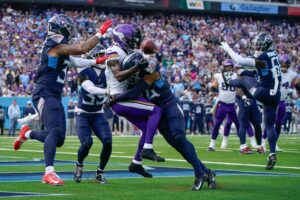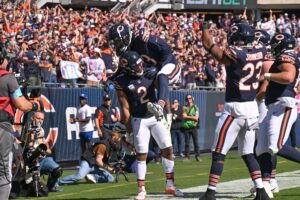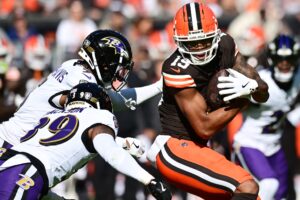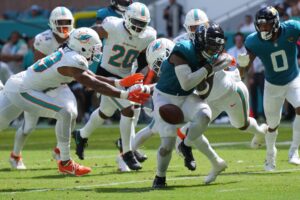The Baltimore Ravens capped off another draft by selecting 10 young NFL hopefuls in the 2020 NFL Draft. From Thursday to Saturday Night, general manager Eric DeCosta and head coach John Harbaugh worked the phones and drafted their newest crop of potential playmakers. The Ravens are known for being one of the best drafting franchises in the entire league and they went about their business successfully yet again. Baltimore had a number of pressing needs entering the draft and addressed almost all of them — picking up a few luxury selections in the process. They manoeuvred up and down the draft board all weekend and landed a number of outstanding players that will hopefully soon, become faces of the franchise.
With the 2020 draft officially behind them, this is how the Ravens draft graded out at first glance.
Baltimore Ravens 2020 NFL Draft Grades
First Round 28th Overall: Patrick Queen (LSU) – Linebacker
There wasn’t a lot to not like about the Ravens first selection in the 2020 draft. Baltimore had their pick of multiple quality receivers and edge rushers but instead, opted to fill a huge need. The inside of the Ravens linebacking core was completely remade during the middle of the 2019 season and only one contributor, L.J. Fort, was retained past the end of last season. However, moving into 2020 and further, the Ravens may have found a very valuable piece on the inside of their defense. The Ravens have historically had teams led by their linebackers and Queen could follow in the footsteps of Ray Lewis and C.J. Mosley.
Queen is a bit untested as a linebacker but really came into his role at LSU as he gained more starts in 2019. The former-Tiger only started a career-high nine games in Baton Rouge last season. He ended the year with 85 total tackles, 12.0 tackles for loss, 3.0 sacks and one interception. His stat line speaks to how complete he is as a player. Queen has the ability to get wide and get into the backfield, while also being able to drop back in coverage. No matter where he’s playing, he thumps players when he gets to them. This pick checked all the boxes: fills a need, best player available, and great positional value for where he was taken.
Grade: A+
2nd Round (55th overall): J.K. Dobbins (Ohio State) – Running Back
If there was a team that running backs would love to come to, it’s the Ravens. With Mark Ingram turning 30 years old this past year, the Ravens lead back from 2019 is entering the period in which running backs typically begin to decline. With the 55th pick, the Ravens had a number of options. They could’ve addressed their pass rush or wide receiver depth but instead opted to take one of the most productive running backs in college last season. Dobbins was widely considered one of the top-50 players in the draft and the Ravens might have given him his best-case scenario.
Dobbins finished his last season at Ohio State with the third-most rushing yards (2003) and third-most rushing touchdowns (21) in the entire NCAA. He’s not the most versatile running back but has done his best work when he’s been paired with a dual-threat quarterback — whether it was J.T. Barrett or Justin Fields. Now he gets maybe the most dynamic dual-threat quarterback of all-time to pair himself with in Lamar Jackson. Dobbins should be a good two-down back to pair with Justice Hill for the long run in Baltimore. The Ravens now have a luxury of running backs.
Grade: B-
3rd Round (71st overall): Justin Madubuike (Texas A&M) – Defensive Tackle
The Ravens made it no secret they were interested in picking Madubuike. The team was in contact with the defensive tackle multiple times prior to the draft and they got their guy by trading back earlier in the third round. When you compare Madubuike to the other two defensive linemen the Ravens brought in during the free agency period, Calais Campbell and Derek Wolfe, he looks a bit undersized. However, he’s still 6’3″ 293 lbs and the Ravens have never had a problem with smaller tackles. Both Brandon Williams and Michael Pierce both contributed heavily to the Ravens run defense over the past three seasons and both stand under 6’2″.
Madubuike will ad more than just depth to the Ravens defensive line. Baltimore has made a conscious decision this off-season to acquire interior players that can get to the quarterback and Madubuike provides this quality as well. He was debatably the most fluid moving defensive tackle at the NFL Combine and recorded 21.5 tackles for loss, 11.0 sacks, and four forced fumbles in his last two seasons at A&M. Run defense is his specialty but getting an interior lineman that can defend the run and get to the quarterback is very valuable in the third round. Madubuike is athletic, explosive and should develop very well within Don Martindale‘s defense. There’s a lot to like about the way he fits in the Ravens defense.
Grade: A-
3rd Round (92nd overall): Devin Duvernay (Texas) – Wide Receiver
The track team in Baltimore is continuing to evolve. Baltimore was already one of the fastest teams in the NFL and added another speedster on day two in Duvernay. The former-Longhorn tied for fifth-fastest time in the Forty Yard Dash at the NFL Combine, posting an official 4.39 seconds time. If you’re keeping track, this now gives the Ravens Marquise Brown (presumed 4.3), Miles Boykin (4.42), Justice Hill (4.4), Duvernay, and the fastest quarterback in NFL history. Simply put, the Ravens do not want speed to ever be an issue on offense. Coach Harbaugh showed incredible emotion on the draft broadcast when Duvernay was selected and he was also, “One of (Decosta’s) favorite players in the draft.”
Duvernay put himself on the map throughout the college football season, playing mostly out of the slot for Texas and seeing his numbers improve because of it. He caught 65 more balls, recorded over 800 more yards, and punched in six more touchdowns during the 2019 season than his 2018 season. Duvernay finished the year with 106 catches for 1,386 yards and 10 total touchdowns. Per PFF, Duvernay was targetted 244 times and dropped just five passes. Willie Snead will likely man the slot early in the season but Duvernay could be a contributor early and often down the road in the Ravens offense.
Grade: B+
3rd Round (99th overall): Malik Harrison (Ohio State) – Linebacker
After a year in which the Ravens blew up their linebacking core midseason, DeCosta doubled down at linebacker in the draft by taking Harrison with their third pick of the third round. While Harrison doesn’t have the ceiling that Queen has, he’s a safer option in the middle of the field who soundly tackles everywhere he is needed. Defending the run at the second level was a big problem for the Ravens early in the year until the acquisition of Josh Bynes. Bynes, however was lost this year in free agency to the Cincinnati Bengals. Harrison should provide that missing presence as soon as next season.
Harrison comes to the Ravens as one of the best tackling linebackers in the draft. He is built like a prototypical Mike linebacker at 6’3″ 247 lbs and should be featured early on rushing downs. The Ravens have been lacking a player that can come downhill on the blitz to stop the run since the departure of C.J. Mosley last off-season. Harrison isn’t overly athletic but he is about as tough and rugged as linebackers come. Considering there was no guarantee Queen would land with the Ravens in round-one and DeCosta and Harbaugh took Harrison in spite of this, they clearly got a guy they loved in round three.
Grade: B+
3rd Round (106th overall): Tyre Phillips (Mississippi State) – Offensive Line
After playing left tackle for Mississippi State in 2019, Phillips comes to the Ravens with aspirations of competing for the spot that Marshal Yanda vacated at the end of last season. Phillips has a tremendous frame at 6’5″ 331 lbs and arm lengths of 35 1/8″, and has more than enough power to become an effective force in the run game. With the way he smoothly rolls his hips into contact, players do not get through him. There are going to be times early in his career in which he struggles in pass protection but transitioning to guard should at least help him minimize some of his concerns when moving backward. Phillips likely will not be a day one starter but will at least have a chance to compete for a job with the right guard position still up in the air.
Grade: C+
4th Round (134th overall): Ben Bredeson (Michigan) – Guard
As mentioned before, there is going to be a lot of competition for the starting right guard spot in the Ravens offense. Between Bredeson, Phillips, and 2019 fourth-round pick Ben Powers, the job is up for grabs. Typically when the Ravens take a player from Michigan, they have done their research and have gotten the inside scoop from John’s brother Jim Harbaugh. Bredeson is my bet to start at right guard for the Ravens week one of the 2020 NFL season.
While Phillips was the higher selection, Bredeson is the more polished prospect. He started every game for the Wolverines at left guard over the past three seasons and was a third-team AP All-American as a senior in 2019. Bredeson’s calling card is also the opposite of Phillips. Per Pro Football Focus, he was the best pass-blocking guard in the country in 2019 — surrendering no quarterback hits or sacks on the year. He is somewhat narrow for a 6’5″, 316 lbs lineman but is no slouch in the run game. Bredeson showed good power in college and will maul players through contact. Replacing Yanda is impossible but Bredeson could be a day-one contributor in Baltimore next season.
Grade: B+
5th Round (170 overall): Broderick Washington (Texas Tech) – Defensive Tackle
The Ravens double-dipped at a second position on day three and it was not a position that many were anticipating. Washington is the kind of player the Ravens love to take at defensive tackle but they usually do it through undrafted free agency. Using a fifth-round pick when Baltimore still has a pressing need at outside linebacker seems a bit odd after already selecting a defensive tackle they really liked high in the third round.
Washington is a fine run stopper but offers very little as a pass rusher. He’s a good fit for the Ravens as he was moved up and down the defensive line at Texas Tech and brings decent production — registering 12.0 tackles for loss and 5.5 sacks in his last two seasons in college. Washington will now become the third first-year defensive tackle on the Ravens in 2020 if he is to make the 53-man roster. This was maybe the first head-scratching pick of the DeCosta era but Washington still has the potential to become yet another diamond in the rough for the Ravens at the defensive tackle position.
Grade: C-
6th Round (201st overall): James Proche (SMU) – Wide Receiver
For a long time, the Ravens have preached production in college transfers to the NFL. They then proceeded to get maybe the most productive receiver in the NCAA last season with their sixth-round selection. Proche caught a wild 111 passes for SMU, dropping just three targets in 2019, and recorded the third-most receiving yards in the AAC with 1225 last season. He will enter the Ravens looking a lot like his fellow draftee Duvernay. Both played inside and outside over their college careers, and come in on the smaller side — Proche at 5’11″201 lbs. Coach Harbaugh said on an NFL Draft broadcast that he expects Proche to contribute to the return game as well. The Ravens sorely needed a returner over the past two seasons and if Proche can just fill out that role, this pick would be a successful one.
Grade: B
7th Round (219th overall): Geno Stone (Iowa) – Safety
Determining if a team hits or misses on a seventh-round pick is difficult to ascertain. In this instance, the Ravens did the safe thing by taking a smart player. As a two year starter, Stone’s best trait is his football IQ. He can play both safety positions but has limited upside due to his lack of athleticism as a defensive back. However, he did a good job of forcing turnovers at Iowa. Over his last two years in the Hawkeyes defense, Stone forced four forced fumbles and five interceptions. The Ravens safety depth is thin behind their two starters, with Anthony Levine now 33 years old and DeShon Elliott often injured, and Stone could be a necessary addition as soon as next year. The Ravens understand you can never have enough depth in the secondary.
Grade: B
2020 Overall Grade: B+
Maybe the Ravens have set the bar too high after having two of the best drafts in franchise history in 2018 and 2019, but 2020 felt a little safe. DeCosta and Harbaugh were likely happy with their selections but their choice to neglect picking a pass rusher, despite multiple chances at good-value players, is an interesting choice. The Ravens have just one edge defender – Jaylon Ferguson – signed through the 2021 season and he has only seen one season of NFL action. However, if DeCosta chose to pass on a number of higher-end prospects, such as Julian Okwara in the second round, Curtis Weaver in the third/fourth round, and Bradlee Anae in the fifth round, they are obviously confident in the talent they possess in-house or saw higher value in the players they picked.
Don’t be mistaken, the Ravens did a number of great things in the draft. They fortified the interior of the defensive line for years to come, they brought in multiple players to compete for Yanda’s old job, and perhaps most impressively, added two very good pieces to the linebacking core, the team’s worst position group in 2019. This class has a lot to live up to, following the success the last two classes have had, but these recent draftees still look like a group that should help the Ravens compete for a Super Bowl in 2020.
Main Image:






